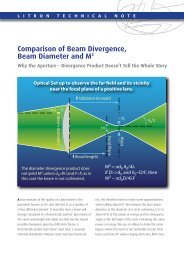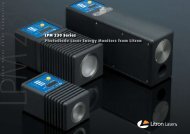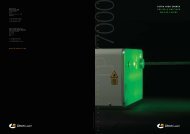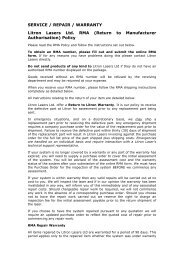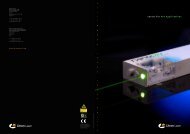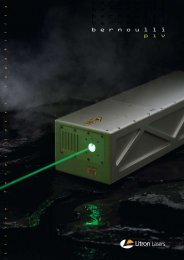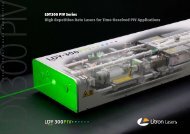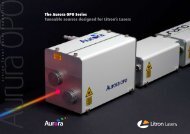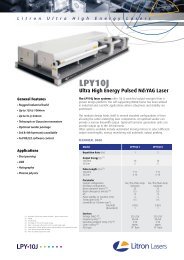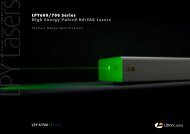You also want an ePaper? Increase the reach of your titles
YUMPU automatically turns print PDFs into web optimized ePapers that Google loves.
Near field beam profile<br />
of <strong>Nano</strong> S with stable<br />
resonator at 1064nm.<br />
Near field profile of<br />
<strong>Nano</strong> L running<br />
TEMoo at 1064nm.<br />
Resonator Types<br />
TEM STABLe ReSONATOR<br />
oo<br />
A stable resonator provides the greatest flexibility in terms of output energy and repetition rate, as<br />
both parameters can be varied with minimal effect upon the alignment of the system. in general, the<br />
output of such systems is multi-mode. With the addition of an intra-cavity aperture, a TeM 00 output<br />
can easily be realised, but at the expense of overall efficiency.<br />
GAuSSiAN ReSONATOR<br />
Gaussian<br />
In a Gaussian system, graded reflectivity mirrors are used, and form part of an unstable resonator. Such<br />
systems give a high energy single transverse mode with a low beam divergence. However this optical<br />
configuration does have drawbacks. The thermal lens formed by the laser rod is part of the optical<br />
arrangement. Such systems will therefore only work properly at one repetition rate, when the thermal<br />
loading on the laser rod is constant. As a direct result of this, the laser is factory set at one pulse<br />
repetition frequency and output energy. To overcome these limitations, which are governed by the<br />
physics of the system, <strong>Litron</strong> offers two options. The<br />
first option, the pulse repetition rate<br />
divider, allows the user to divide the set<br />
repetition rate by 2, 4, 8 or 16. This works<br />
by allowing the flashlamp to pulse at a set<br />
frequency, thus maintaining almost the<br />
same thermal lens on<br />
the laser rod, but only<br />
switching the Pockels<br />
cell on the desired pulses<br />
(i.e. every other pulse for<br />
divide by two operation). The second option is a motorised variable optical<br />
attenuator. By the use of an extra-cavity polariser and half-wave plate, the<br />
output energy of the laser can be attenuated, whilst maintaining the<br />
Multimode<br />
beam quality and divergences required.<br />
213nm<br />
in a system fitted with Gaussian optics, the pulse length tends to be shorter than in a conventional sta-<br />
ble resonator. This increases the peak power density that is seen by the resonator optics and subse-<br />
quently by any beam handling optics that may be used.<br />
TeLeScOPic ReSONATOR<br />
To obtain high energy low divergence beams, the preferred method is the use of a telescopic resona-<br />
tor. in this configuration, an intra-cavity telescope is used to reduce the beam diameter in the rear leg<br />
of the resonator. This has the effect of making the resonator appear longer, increasing the losses in the<br />
higher order modes, leading to a superior output beam with very low divergence. With no optical adjust-<br />
3<br />
4<br />
1<br />
2<br />
Rear Mirror<br />
Q-Switch<br />
Nd:YAG Rod<br />
Output Coupler<br />
Graded Reflectivity<br />
Output Coupler<br />
Rear Mirror Aperture<br />
Telescope Q-Switch Nd:YAG Rod<br />
Output Coupler<br />
Schematics showing<br />
oscillator design.<br />
1) Stable<br />
2) Gaussian<br />
3) Telescopic Multimode<br />
4) Telescopic TEMoo 266nm<br />
Distribution of the output energy per<br />
pulse for 500 consecutive shots.<br />
<strong>Range</strong> of histogram ± 1% ofmean<br />
value. Standard devitaion ~0.3%.<br />
355nm<br />
532nm<br />
ment at all, the laser can be varied over a wide range of pulse energies and repetition<br />
rates, whilst maintaining a high quality, low divergence beam. With slight adjustment<br />
to the telescope (a simple procedure) the full range of energies and repetition rates<br />
from single pulse to the maximum can be achieved. For high energy TeM 00 beams, an<br />
intra-cavity aperture can be fitted behind the telescope. Varying the sizes of these apertures allows<br />
output beams that are to within 15% of the diffraction limit to about 2.5 times the diffraction limit. That<br />
is from an almost pure Gaussian TeM 00 to full energy in a uniform spatial profile. The output from a<br />
telescopic resonator is longer and smoother temporally, making it the system of choice for pumping dye<br />
lasers or optical parametric oscillators. Such arrangements, by virtue of the longer pulse length, are much<br />
less prone to optical damage than Gaussian systems.<br />
OSciLLATOR AMPLiFieR SySTeMS<br />
In order to generate high energy laser outputs, or to generate medium energy outputs at very high<br />
repetition rates, the use of an amplifier stage is often beneficial. An oscillator amplifier is advantageous<br />
over a single high energy oscillator for several reasons. in an oscillator, the energy that can be extracted<br />
is governed by the Q-switch hold off, parasitic oscillations and amplified spontaneous emission. in an<br />
amplified system, the oscillator is not usually run at its maximum output (as dictated by the maximum<br />
stored energy of the laser rod), therefore the peak powers are lower through the cavity optics and<br />
Pockels cell, leading to longer life and more reliable service. When using an oscillator and amplifier to<br />
obtain output energies greater than about 500mJ, the near field spatial profile is usually better,<br />
containing less structure than an equivalent single oscillator yielding the same output.<br />
A range of amplifiers can be fitted to the <strong>Nano</strong> series, in an oscillator amplifier<br />
arrangement, the oscillator is typically one of the standard <strong>Nano</strong> range. The output is<br />
then folded to pass through the amplifier rod. The amplifier design uses a single lamp<br />
pumped rod housing, of the same design as those used in the oscillators. With the use<br />
1064nm<br />
of a suitable amplifier stage, outputs of >1200mJ are available from the <strong>Nano</strong> series.<br />
HARMONic GeNeRATiON<br />
<strong>Litron</strong> offers a full range of harmonic generation and separation modules, giving<br />
the customer access to 532nm, 355nm, 266nm and 213nm. There are two types<br />
of harmonic housing available: a short form housing and a long form housing.<br />
These can be added and removed as required and can usually be retrofitted. The<br />
short housing is ideal for applications which require only 532nm, this contains a frequency doubling<br />
crystal and dichroic separation mirrors. The long harmonic housing can hold a frequency doubler, or a<br />
frequency doubler and tripler, or a frequency doubler and quadrupler, and dichroic separation mirrors.<br />
Typically KTP or LBO are used as frequency doublers, LBO or BBO are used as frequency triplers and BBO<br />
is used as a frequency quadrupler. Temperature stabilisation of the crystals is available.




